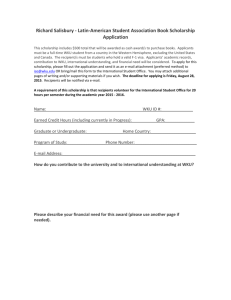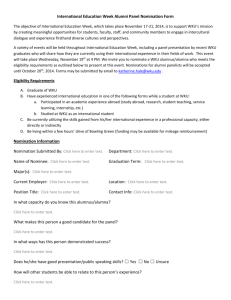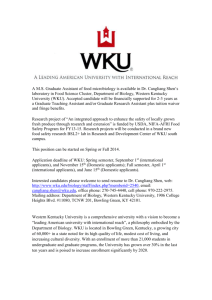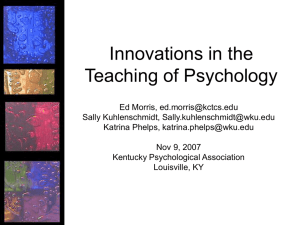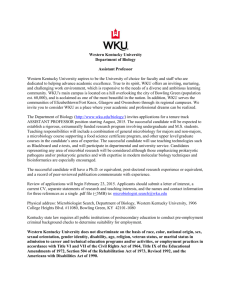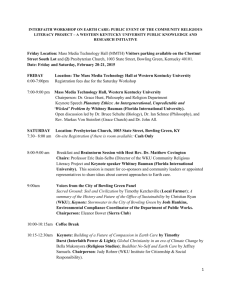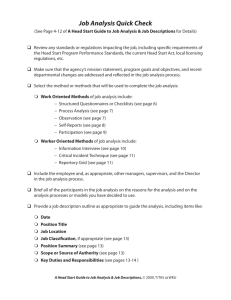33rd Annual Mathematics Symposium - Western Kentucky University *= student presentation
advertisement
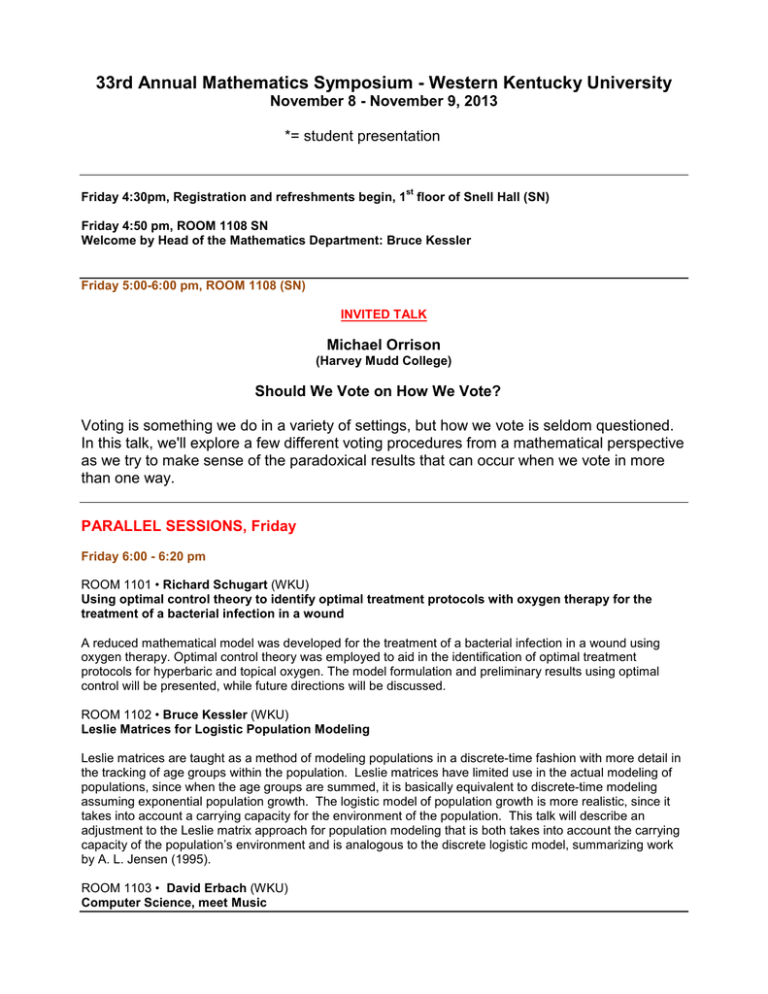
33rd Annual Mathematics Symposium - Western Kentucky University November 8 - November 9, 2013 *= student presentation st Friday 4:30pm, Registration and refreshments begin, 1 floor of Snell Hall (SN) Friday 4:50 pm, ROOM 1108 SN Welcome by Head of the Mathematics Department: Bruce Kessler Friday 5:00-6:00 pm, ROOM 1108 (SN) INVITED TALK Michael Orrison (Harvey Mudd College) Should We Vote on How We Vote? Voting is something we do in a variety of settings, but how we vote is seldom questioned. In this talk, we'll explore a few different voting procedures from a mathematical perspective as we try to make sense of the paradoxical results that can occur when we vote in more than one way. PARALLEL SESSIONS, Friday Friday 6:00 - 6:20 pm ROOM 1101 • Richard Schugart (WKU) Using optimal control theory to identify optimal treatment protocols with oxygen therapy for the treatment of a bacterial infection in a wound A reduced mathematical model was developed for the treatment of a bacterial infection in a wound using oxygen therapy. Optimal control theory was employed to aid in the identification of optimal treatment protocols for hyperbaric and topical oxygen. The model formulation and preliminary results using optimal control will be presented, while future directions will be discussed. ROOM 1102 • Bruce Kessler (WKU) Leslie Matrices for Logistic Population Modeling Leslie matrices are taught as a method of modeling populations in a discrete-time fashion with more detail in the tracking of age groups within the population. Leslie matrices have limited use in the actual modeling of populations, since when the age groups are summed, it is basically equivalent to discrete-time modeling assuming exponential population growth. The logistic model of population growth is more realistic, since it takes into account a carrying capacity for the environment of the population. This talk will describe an adjustment to the Leslie matrix approach for population modeling that is both takes into account the carrying capacity of the population’s environment and is analogous to the discrete logistic model, summarizing work by A. L. Jensen (1995). ROOM 1103 • David Erbach (WKU) Computer Science, meet Music Computer Science and Music are academic outliers in somewhat similar ways. As university disciplines, both have a substantial practical component, both have an often-neglected theoretical substratum, and both tend to be judged by the public performance of what they do. But the two disciplines have chosen very different paths for the instruction of young professionals. This talk will examine these parallels and differences more closely. It will then discuss methods which musicians have learned are effective for training their students, and discuss whether they might also be effective if adapted for use in Computer Science instruction. Friday 6:30 - 6:50 pm ROOM 1108 • Miriam M. El-Farrah*, Eleanor Ezell*, Daniel Jones*, Rebecca McPhearson*, Jeremiah Stringer*, Aaron Wallace*, Claus Ernst (WKU) Mathematical Comedy (in two acts) Act 1. How Pythagoras discovered his famous law Act 2. The story of Rumpled Stiltsken – hiring in the math department Friday 7:00-7:40pm Food and Refreshments! Friday 7:40 - 8:00 pm ROOM 1101 • Joseph Daws*, Nikolay Brodskiy (University of Tennessee at Knoxville) A Fundamental Theorem of Multivariable Calculus in Dimension Two We present a generalization of a part of the Fundamental Theorem of Calculus. The motivation and the proof are based on a few simple ideas involving two products of vectors (the dot product and the determinant) and one identity relating the two products. Our generalization resembles both the statement and the proof of the Fundamental Theorem of Calculus at both the conceptual and technical levels. Our presentation is designed to allow even further generalizations to higher dimensions. ROOM 1102 • John Cliburn* (Gatton Academy), Lan Nguyen (WKU) The Banach Fixed Point Theorem and Its Applications We investigate the application of the Banach fixed point theorem, especially as it applies to initial value problems in differential equations. Many partial differential equations (PDE’s) model biological growth and can be reduced to ordinary differential equations (ODE’s) with time delay on a real Banach space. Other PDE’s are abstract and inhomogeneous. For any contraction operator on a Banach space, the Banach fixed point theorem can be used to prove the existence and uniqueness of a solution to these equations. ROOM 1103 • Lindsey Traughber*, David Neal (WKU) Sums of Independent Geometric Random Variables Suppose you are presented with two card games and are asked to choose the one for which you would like to bet money. In each game you are given six draws, with replacement, from a standard deck of cards. In order to win the first game, you must draw three red cards within the six given attempts, and in order to win the second game, you must draw one red, one non-Joker, and one club. Which game should you choose to play if you want the highest possible chance of winning? In this talk, we use sums of independent geometric random variables to solve this problem. We also will compare probabilities, finding the probability that the first game will end before the second, provided we let each game continue until all desired cards have been drawn. Friday 8:10 - 8:30 pm ROOM 1101 • Jason Rosenhaus (James Madison University) Non-classical Knights and Knaves Puzzles about liars and truthtellers have a long history. They have tremendous pedagogical value for introducing people to sophisticated ideas in logic. We shall introduce these ideas with some entertaining examples, and will then discuss possible extensions of the classical puzzles to nonclassical logics. ROOM 1102 • David Roach (Murray State University) Frequency selective parameterized wavelets of length ten A wavelet is a finitely supported function who together with all of its dilations and integer shifts forms a basis that can be used to represent complicated signals such as images in an efficient way. Typically, when someone wishes to use a wavelet, they choose from among a discrete handful of standard wavelets such as the Daubechies wavelets (D4, D6, D8, D10, etc.) or some biorthogonal wavelets like the CDF 9/7 used with the FBI standard. There is a rule of thumb that "any good wavelet will do", but in reality the wavelet performance in a particular application is highly dependent on the type of signal that is being represented. In this talk, I will present a parameterization of the length ten wavelets that consists of a continuum of all wavelets of that length with various properties such as the number of vanishing moments, regularity, and frequency response. In particular, I will give an example of some length ten parameterized wavelets which consistently perform better than the standard Daubechies wavelet of length ten and perform comparable or bettter than the CDF biorthogonal 9/7 on some images in an image compression scheme. These frequency selective parameterized wavelets perform better than the Daubechies wavelets because their frequency response is closer to the ideal filter allowing a stronger segmentation between the high and low frequencies within a given signal. ROOM 1103 • Nitin Krishna*, Hannah Pennington*, Richard Schugart (WKU) A Mathematical Model for the Interaction of the Proteins MMP-1, TIMP-1, and ECM in a Wound In this talk, we will discuss a mathematical model describing interactions among matrix metalloproteinases (MMP-1), their inhibitors (TIMP-1), and extracellular matrix (ECM) in the healing of a diabetic foot ulcer. Deidentified data for modeling were taken from Muller et al. 2008, a research outcome that collected average physiological data for two patient subgroups: “good healers” and “poor healers,” where classification was based on rate of ulcer healing. MATLAB’s GlobalSearch and fmincon routines were used to estimate parameter values by minimizing the least-squares residual between collected data and model output. A steady-state analysis identified which end-states the proteins tended to as time approached infinity. Sensitivity analyses numerically measured to what degree the model was affected by slight changes in one or several parameter values. A classical sensitivity analysis followed by a SVD-QR subset selection and a Latin-Hypercube Method sensitivity analysis identified insensitive parameters, or parameters whose changes had negligible effects on the model. The developed model has the potential for application in clinical studies, such as identifying treatment regimens for an individual patient not included in the modeling process. ____________________________________________________________________________________ Saturday from 8:00 am - Registration and refreshments, First Floor of Snell Hall (SN) REGISTRATION continues until 11:00am SATURDAY PARALLEL SESSIONS, Saturday Saturday 8:30 - 8:50 am ROOM 1101 • Dominic Lanphier (WKU) Duels, Truels, Gruels, and Survival of the Unfittest Duels are types of two person games where each player shoots under various conditions. We introduce two types of generalizations of sequential duels. One generalization is to several players, where truels and $n$uels can be considered as examples. The other generalization is to duels where it takes more than one hit to eliminate a player from the game. The main issue of study is to determine which player is the most likely to win (or survive) such a duel-type game. Combinatorial and analytic methods are used to study these games. ROOM 1102• Miky Wright*, David Neal (WKU) Four-Sided Boundary Problem for Two-Dimensional Random Walks Within the four-sided boundaries of x = 0 y = 0 x = m and y = n , a two-dimensional random walk begins at integer-valued coordinates (h, k) , and moves one unit on each step either up, down, left, or right with non-zero probabilities that sum to 1. The process stops when hitting a boundary. Let P(U) , P(D) , P(L) and P(R) be the probabilities of hitting the upper, the lower, the left, and the right boundary first, respectively, when starting from a specific initial point within the boundaries. We use a Markov-Chain method to compute these probabilities. Let x i, j be the probability of hitting the left boundary first, when starting at coordinates ( i , j ). We use a System of Equations method to find x i, j simultaneously for all possible starting points ( i , j ). ROOM 1103• Sutthirut Charoenphon*, Ferhan Atici (WKU) Green’s functions of Discrete Fractional Calculus In my talk, I will introduce the discrete fractional calculus. It is the discrete version of fractional calculus. First, I will define the delta operator as the forward difference operator and the falling factorial powers. Next, I will introduce the basic properties of finite fractional difference i.e. the power rule, the product rule, the quotient rule, some properties of exponents, the fractional sum and the fractional difference. Furthermore, we will calculate Green’s functions of some boundary problems of discrete fractional equations. Last, I will demonstrate how my findings generalize the existence results in the literature. Saturday 9:00 - 9:20 am ROOM 1101 • Claus Ernst (WKU) The effect of confinement on knotting and geometry of random polygons Motivated by a DNA strand in a viral capsid we create a model of an equilateral random polygons of length n in a confinement sphere of radius R>1. In this talk we discuss how knotting probabilities and geometric properties of the random polygons change as a function of both n and R. Even for relatively small length (in our study we use polygons of a length up to 90 steps) such random polygons are knotted with very high probability and theknots obtained are very complex (i.e. the knots have more than 16 crossings and cannot be identified). ROOM 1102 • Zachary French*, James Hart (Middle Tennessee State University) A Characterization of Stone Duality: Boolean Algebras and Stone Spaces Stone Duality marked a milestone in foundational mathematics when it was first characterized by Dr. Marshall Stone in 1937. Inspired by his work in Hilbert spaces, Dr. Stone discovered that Boolean algebras, when properly considered through their spectrum of prime ideals, could be represented as topological spaces, specifically those with the properties of being compact Hausdorff spaces with bases of clopen sets. Moreover, Dr. Stone demonstrated that any compact Hausdorff space with a basis of clopen sets could be represented as a Boolean algebra. This meant that previously unproven results in both Boolean algebra and topology could be approached using the tools of its respective counterpart. This discovery anticipated the formation of what would become category theory, and continues to yield significant results to this day. ROOM 1103 • Hailee Peck*, Joseph Stickles (Millikin University) Irreducible Divisor Graphs with Respect to Tau-Relations Since the introduction of the zero-divisor graph by Beck in 1988, graphical structures associated with algebraic concepts have quickly become a significant area of research in commutative ring theory. A relatively recent extension of graphical research is the irreducible divisor graph, introduced in 2007 by J. Coykendall and J. Maney. This graph provides insight into the factorizations of nonzero, nonunit elements into irreducible divisors. One of these such graphs, the τ-irreducible divisor graph, was first introduced by Mooney in 2012. To aid in our investigation of the τ-irreducible divisor graph, we worked to write a MatLab code that will generate factorizations of an integer with respect to certain relationship criteria. ROOM 1108 • Asit Saha (Central State University), Sean Kohles (Kohles Bioengineering) The Multi-scale Influence of Externally Imposed Nano-Mechanical Stresses on the Dynamics of Chondrocytes’ Proliferation and Migration along with Extracellular Matrix Molecule Accumulation in Engineered Tissue The most important factor in regenerative medicine involves design of engineered tissues based upon the guided balance between individual cells and it’s extracellular space known as, their extracellular matrix (ECM). A key factor of this complex biology is to understand the physicochemical interactions at multiple scales (pico-level 10-12, nano- level 10-9, micro-level 10-6 and so on.) with respect to time, structure and, functional characteristics. A feasible biokinetic regulation along with its spatial distribution is vital for creating appropriate nanotechnologies that may support cellular and molecular engineering. The objective of this study is to develop a systems-biological model that describes cellular proliferation and migration and ECM structural molecule metabolism in an engineered cartilage construct taking into account localized environmental changes. In our previous studies, we have constructed a number of systems-based biokinetics models exploring the nanoscale structural biomolecular response at the extracellular matrix level to the controlled microenvironments generated through static and dynamic mechanical loadings. In the present study, we explore a precise mathematical framework to understand biokinetic regulation along with cellular proliferation and migration long extracellular matrix distribution in engineered tissue. Our model outcomes will provide an enhancement in current mechanotransduction properties for application at the cellular and molecular levels. Saturday 9:30 - 9:50 am ROOM 1101 • Bekka Ross*, Tom Richmond (WKU) A Continued Fraction Cryptography System We are developing a cryptography system using continued fractions. This system will encode each of the 26 letters in the alphabet using a 1-1 function that assigns a value to each letter and computing the continued fraction of that value divided by a prime p. However, to avoid this system becoming just a substitution cipher, we employ a shifting method which will take the final digit of the last partial quotient of the continued fraction and shift the assigned value of the next letter in the message by that number. We want the shifts for a specific letter to be widely varied, so we want to find consecutive sequences of continued fractions whose final digits are widely distributed. Some data and examples will be given. ROOM 1102 • Mahdi Bandegi * (WKU) Rearranging Series In this talk we discuss rearrangements of series to create convergent series. Using examples we show a divergent series can be made to converge, while the same rearrangement will preserve convergence of convergent series. This talk is based on a paper by Steven G. Krantz and Jeffery D. McNeal. ROOM 1103 • Khalid Almohammadi * (WKU) Optimization without Calculus In this talk we present an algebraic solution to atypical optimization problem found in calculus. It is of interest to note that famous mathematicians like Rene Descartes and Pierre de Fermat considered similar problems before the invention of calculus. Our talk is based on a paper by Michael Bolt and Danied Isaksen. Saturday 10:00 - 10:20 am ROOM 1101 • Kathleen Bell*, Shania Polson*, Tom Richmond (WKU) Optimal Path between Two Points with an Obstacle Consider a path from point A = (0, 1) to point B = (1,0). Suppose there is a square obstacle with one vertex on the origin and the opposite vertex on the point (a, a) where a < 1. If the rate of travel through the obstacle is slower than the rate of travel in the surrounding area, we discuss the optimal path from point A to point B. ROOM 1102 • Sai Veeramachaneni*, Uta Ziegler (WKU) Generating random walks with thickness DNA is packed very tightly in many living organisms, for example cell nucleus in the human body. The details of the packing mechanisms involved are still an area of intense study. In our project, we investigate mathematically derived random packing mechanisms and the packings they generated. We model DNA as a randomly generated walk. A walk is a chain of unit length, freely-jointed segments that are considered volumeless. The confinement is modeled as a sphere of certain radius. The goal of the project is to include thickness (volume) to the segments in the model to analyze the features of these walks. The talk explains an algorithm to generate walks within confinement with thickness and without thickness. The talk will include some preliminary results comparing both packing methods. ROOM 1103 • Mark Robinson (WKU) Some Observations on Newton's Method and its Convergence When faced with the problem of approximating a solution to a nonlinear equation, one of the best-known and most efficient methods is Newton's method, which is both a linearization method and a fixed-point iteration method. We consider the convergence behavior of Newton's method, including the choice of the initial approximation and the speed of convergence under different circumstances. Although the primary focus will be on the single-variable case, the multivariable version of Newton's method, for solving nonlinear systems of equations, will also be considered. Saturday 10:30-11:00 am, Refreshments Saturday 11:00 - 12:00 pm, ROOM 1108 (SN) INVITED TALK Sir Vaughan Jones (Vanderbilt University) Why I love Knots For one who ties knots a knot is a piece of rope, string, nylon or such like that is to be manipulated into a certain shape according to usefulness or aesthetics For the mathematician it is an infinitely think, smoothly deformable closed curve in three dimensional space. I will explain knots both from a theoretical and practical point of view including the odd anecdote about how both aspects influence my professional and recreational life. Funding for the 2012 Symposium at WKU is provided by NSF grant DMS-0846477 through the MAA Regional Undergraduate Mathematics Conferences Program, www.maa.org/RUMC, by Ogden College of Science and Engineering, WKU, by Carol Martin Gatton Academy of Mathematics and Science, WKU, and by the Department of Mathematics, WKU.
